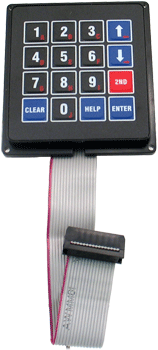TS-7250-V3 DIO Header: Difference between revisions
From embeddedTS Manuals
No edit summary |
m (Links auto-updated for 2022 re-branding ( https://github.com/embeddedarm/ts7100-utils/blob/master/src/keypad.c → https://github.com/embeddedTS/ts7100-utils/blob/master/src/keypad.c)) |
||
| Line 67: | Line 67: | ||
[[File:KPAD.jpg|200px|right]] | [[File:KPAD.jpg|200px|right]] | ||
The DIO header is designed to provide compatibility with the KPAD accessory. This is a 4x4 numerical keypad. This is supported in userspace with the [https://github.com/ | The DIO header is designed to provide compatibility with the KPAD accessory. This is a 4x4 numerical keypad. This is supported in userspace with the [https://github.com/embeddedTS/ts7100-utils/blob/master/src/keypad.c keypad.c] source code, or the "keypad" utility which is included in the shiping image. | ||
This debounces presses to 50ms, and does not repeat when numbers are held. This will output a string containing the key that is pressed. Eg: | This debounces presses to 50ms, and does not repeat when numbers are held. This will output a string containing the key that is pressed. Eg: | ||
Revision as of 17:06, 17 January 2022
The DIO header is a 0.1" pitch 2x8 header including SPI and GPIO. All pins on this header are 5V tolerant except SPI output pins. All of these DIO includes pullups.
| Signals | Pin Layout | ||||||||||||||||||||||||||||||||||
|---|---|---|---|---|---|---|---|---|---|---|---|---|---|---|---|---|---|---|---|---|---|---|---|---|---|---|---|---|---|---|---|---|---|---|---|
|
- ↑ When this pin is a high output it enables a FET to ground.
The DIO header is designed to provide compatibility with the KPAD accessory. This is a 4x4 numerical keypad. This is supported in userspace with the keypad.c source code, or the "keypad" utility which is included in the shiping image.
This debounces presses to 50ms, and does not repeat when numbers are held. This will output a string containing the key that is pressed. Eg:
root@tsimx6:~# keypad 1 UP DOWN 2ND ENTER

